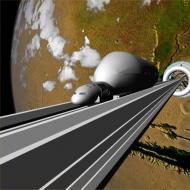
Is it possible to create a space elevator? Space elevator: fantasy or reality? What does nanotechnology have to do with it?
Many people know the biblical story about how people set out to become like God and decided to erect a tower as high as heaven. The Lord, angry, made all the people speak different languages, and the construction stopped.
It’s hard to say whether this is true or not, but after thousands of years, humanity again thought about the possibility of building a supertower. After all, if you manage to build a structure tens of thousands of kilometers high, you can reduce the cost of delivering cargo into space by almost a thousand times! Space will once and for all cease to be something distant and unattainable.
Dear space
The concept of a space elevator was first considered by the great Russian scientist Konstantin Tsiolkovsky. He assumed that if you build a tower 40,000 kilometers high, the centrifugal force of our planet will hold the entire structure, preventing it from falling.
At first glance, this idea smells like Manilovism a mile away, but let's think logically. Today, most of the weight of rockets is fuel, which is spent on overcoming Earth's gravity. Of course, this also affects the launch price. The cost of delivering one kilogram of payload to low-Earth orbit is about $20,000.
So when relatives give jam to the astronauts on the ISS, you can be sure: this is the most expensive delicacy in the world. Even the Queen of England cannot afford this!
Launching one shuttle cost NASA between $500 and $700 million. Due to problems in the American economy, NASA management was forced to close the space shuttle program and outsource the function of delivering cargo to the ISS to private companies.

In addition to economic problems, there are also political ones. Due to disagreements over the Ukrainian issue, Western countries have introduced a number of sanctions and restrictions against Russia. Unfortunately, they also affected cooperation in astronautics. NASA received an order from the US government to freeze all joint projects, with the exception of the ISS. In response, Deputy Prime Minister Dmitry Rogozin said that Russia is not interested in participating in the ISS project after 2020 and intends to switch to other goals and objectives, such as establishing a permanent scientific base on the Moon and a manned flight to Mars.
Most likely, Russia will do this together with China, India and, possibly, Brazil. It should be noted: Russia was already going to complete work on the project, and Western sanctions simply accelerated this process.
Despite such grandiose plans, everything may remain on paper unless a more efficient and cheaper way to deliver cargo beyond the Earth's atmosphere is developed. A total of over 100 billion dollars were spent on the construction of the same ISS! It’s scary to imagine how many “greenies” it will take to create a station on the Moon.
A space elevator could be the perfect solution to the problem. Once the elevator is operational, shipping costs could drop to two dollars per kilogram. But first you will have to thoroughly rack your brains about how to build it.
Margin of safety
In 1959, Leningrad engineer Yuri Nikolaevich Artsutanov developed the first working version of a space elevator. Since it is impossible to build an elevator from the bottom up due to the gravity of our planet, he proposed doing the opposite - building from the top down. To do this, a special satellite had to be launched into geostationary orbit (about 36,000 kilometers), where it had to take a position above a certain point on the Earth's equator. Then begin assembling the cables on the satellite and gradually lower them towards the surface of the planet. The satellite itself also played the role of a counterweight, constantly keeping the cables taut.

The general public was able to become familiar with this idea in detail when, in 1960, Komsomolskaya Pravda published an interview with Artsutanov. The interview was also published by Western media, after which the whole world was subjected to “elevator fever.” Science fiction writers were especially zealous, painting rosy pictures of the future, an indispensable attribute of which was the space elevator.
All experts studying the possibility of creating an elevator agree that the main obstacle to the implementation of this plan is the lack of sufficiently strong material for the cables. According to calculations, this hypothetical material should withstand a voltage of 120 gigapascals, i.e. over 100,000 kilograms per square meter!
The strength of steel is approximately 2 gigapascals, for particularly strong options it is a maximum of 5 gigapascals, for quartz fiber it is slightly above 20. This is simply monstrously low. The eternal question arises: what to do? Develop nanotechnology. The most promising candidate for the role of an elevator cable may be carbon nanotubes. According to calculations, their strength should be much higher than the minimum 120 gigapascals.

So far, the strongest sample has been able to withstand a stress of 52 gigapascals, but in most other cases they have ruptured in the range of 30 to 50 gigapascals. In the course of lengthy research and experiments, specialists from the University of Southern California managed to achieve an unheard-of result: their tube was able to withstand a voltage of 98.9 gigapascals!
Unfortunately, this was a one-off success, and there is another significant problem with carbon nanotubes. Nicolas Pugno, a scientist from the Polytechnic University of Turin, came to a disappointing conclusion. It turns out that even due to the displacement of one atom in the structure of carbon tubes, the strength of a certain area can sharply decrease by 30%. And all this despite the fact that the longest nanotube sample obtained so far is only two centimeters. And if you take into account the fact that the length of the cable should be almost 40,000 kilometers, the task seems simply impossible.
Debris and storms
Another very serious problem is related to space debris. When humanity settled in near-Earth orbit, it began one of its favorite pastimes - polluting the surrounding space with the products of its vital activity. At the very beginning, we were somehow not particularly worried about this. “After all, space is endless! - we reasoned. “You throw away the piece of paper, and it will go on to explore the vastness of the Universe!”

This is where we made a mistake. All the debris and remains of aircraft are doomed to circle around the Earth forever, captured by its powerful gravitational field. It doesn't take an engineer to figure out what would happen if one of these pieces of junk collided with a cable. Therefore, thousands of researchers from all over the world are racking their brains over the issue of eliminating a near-Earth landfill.
The situation with the base of the elevator on the surface of the planet is also not entirely clear. Initially, it was planned to create a stationary base at the equator to ensure synchronization with a geostationary satellite. However, then the harmful effects on the elevator of hurricane winds and other natural disasters cannot be avoided.
Then the idea came up to attach the base to a floating platform that could maneuver and “avoid” storms. But in this case, operators in orbit and on the platform will be forced to perform all movements with surgical precision and absolute synchronization, otherwise the entire structure will go to hell.
Keep your chin up!
Despite all the difficulties and obstacles that lie on our thorny path to the stars, we should not hang our noses and throw this, without a doubt, unique project into the back burner. A space elevator is not a luxury, but a vital thing.
Without it, colonization of near space will become an extremely labor-intensive, expensive endeavor and can take many years. There are, of course, proposals to develop anti-gravity technologies, but this is too distant a prospect, and the elevator is needed in the next 20-30 years.

An elevator is necessary not only for lifting and lowering loads, but also as a “mega-sling.” With its help, it is possible to launch spaceships into interplanetary space without spending huge volumes of such precious fuel, which otherwise could be used to accelerate the ship. Of particular interest is the idea of using an elevator to clean the Earth of hazardous waste.
One of the serious obstacles to the implementation of many stellar projects is that, due to their enormous size and weight, the ships cannot be built on Earth. Some scientists propose collecting them in outer space, where, thanks to weightlessness, astronauts can easily lift and move incredibly heavy objects. But today critics rightly point to the prohibitive cost of space assembly. For example, the complete assembly of the International Space Station will require about 50 shuttle launches, and its cost, including these flights, is approaching $100 billion. This is the most expensive scientific project in history, but the construction of an interstellar space sailboat or ramjet ship in outer space a funnel would cost many times more.
But, as science fiction writer Robert Heinlein liked to say, if you can rise 160 km above the Earth, you are already halfway to any point in the solar system. This is because with any launch, the first 160 km, when the rocket strives to escape the bonds of gravity, “eat up” the lion’s share of the cost. After this, the ship, one might say, is already able to reach either Pluto or further.
One way to dramatically reduce the cost of flights in the future is to build a space elevator. The idea of climbing to the sky using a rope is not new - take, for example, the fairy tale “Jack and the Beanstalk”; a fairy tale is a fairy tale, but if you take the end of the rope into space, the idea could well come true. In this case, the centrifugal force of the Earth's rotation would be enough to neutralize the force of gravity, and the rope would never fall to the ground. She would magically rise vertically and disappear into the clouds.
(Imagine a ball that you spin on a string. The ball does not seem to be affected by gravity; the fact is that the centrifugal force is pushing it away from the center of rotation. In the same way, a very long rope can hang in the air due to the rotation of the Earth.) There is no need to hold the rope; the rotation of the Earth will be enough. Theoretically, a person could climb such a rope and rise straight into space. Sometimes we ask physics students to calculate the tension in such a rope. It is easy to show that even a steel cable cannot withstand such tension; It was in this regard that for a long time it was believed that a space elevator could not be realized.
The first scientist to become seriously interested in the problem of the space elevator was the Russian scientist-visionary Konstantin Tsiolkovsky. In 1895 ᴦ. inspired by the Eiffel Tower, he imagined a tower that would rise straight into outer space and connect the Earth with a “star castle” floating in space. It was supposed to be built from the bottom up, starting from the Earth, from where engineers would slowly build a space elevator to the heavens.
In 1957 ᴦ. Russian scientist Yuri Artsutanov proposed a new solution: to build a space elevator in reverse order, from top to bottom, starting from space. The author imagined a satellite in geostationary orbit at a distance of 36,000 km from the Earth - from the Earth it would appear motionless; from this satellite it was proposed to lower a cable to Earth and then secure it at the lowest point. The problem is that the cable for a space elevator would have to withstand a tension of about 60-100 GPa. Steel breaks at about 2 GPa of tension, which defeats the purpose of the idea.
A wider audience was introduced to the space elevator idea later; in 1979 ᴦ. Arthur C. Clarke's novel The Fountains of Paradise was published, and in 1982. - Robert Heinlein's novel “Friday”. But since progress in this direction has stalled, it has been forgotten.
The situation changed dramatically when chemists invented carbon nanotubes. Interest in them increased sharply after publication in 1991. by Sumio Iijima of Nippon Electric. (It must be said that the existence of carbon nanotubes has been known since the 1950s, but they were not paid attention to for a long time.) Nanotubes are much stronger, but at the same time much lighter than steel cables. Strictly speaking, their strength even exceeds the level required for a space elevator. According to scientists, carbon nanotube fibers should withstand pressures of 120 GPa, which is significantly higher than the all-important minimum. After this discovery, attempts to create a space elevator resumed with renewed vigor.
B 1999 ᴦ. a major NASA study was published; it envisioned a space elevator in the form of a ribbon approximately one meter wide and about 47,000 km long, capable of delivering a payload weighing about 15 tons into orbit around the Earth. The implementation of such a project would instantly and completely change the economics of space travel. The cost of delivering cargo into orbit would immediately decrease by 10,000 times; Such a change cannot be called anything other than revolutionary.
Today, delivering one pound of cargo into low-Earth orbit costs at least $10,000. Thus, each shuttle flight costs about $700 million. A space elevator would bring delivery costs down to $1 per pound. Such a radical reduction in the cost of the space program could completely change the way we think about space travel. With a simple push of a button, you could launch an elevator and ascend into outer space for the same price as, say, a plane ticket.
But before we build a space elevator that can easily take us to the skies, we have to overcome very serious obstacles. Today, the longest carbon nanotube fiber produced in the laboratory is no longer than 15 mm in length. A space elevator would require nanotube cables thousands of kilometers long. Of course, from a scientific point of view this is a purely technical problem, but it is extremely important to solve, and it can be stubborn and difficult. Nevertheless, many scientists are convinced that it will take us several decades to master the technology for producing long cables from carbon nanotubes.
The second problem is essentially that, due to microscopic disturbances in the structure of carbon nanotubes, obtaining long cables may be generally problematic. Nicola Pugno from the Turin Polytechnic Institute estimates that if even one atom in a carbon nanotube is out of place, the strength of the tube can immediately decrease by 30%. Overall, defects at the atomic level can rob a nanotube cable of 70% of its strength; in this case, the permissible load will be lower than the minimum gigapascals, without which it is impossible to build a space elevator.
In an effort to spur the interest of private entrepreneurs in the development of a space elevator, NASA announced two separate competitions. (The Ansari X-Prize competition with a prize of $10 million was taken as an example. The competition successfully fueled the interest of enterprising investors in the creation of commercial rockets capable of lifting passengers to the very edge of outer space; the announced prize was received in 2004 by the SpaceShipOne ship.\"7d NASA competitions are called Beam Power Challenge and Tether Challenge.
To win the first of these, a team of researchers must create a mechanical device capable of lifting a load weighing at least 25 kg (including its own weight) up a cable (suspended from, say, a crane boom) at a speed of 1 m/s per height of 50 m. The task may seem simple, but the problem is that this device does not need to use fuel, batteries or an electrical cable. Instead, the robotic lift must be powered by solar panels, solar reflectors, lasers or microwave radiation, i.e. from those energy sources that are convenient to use in space.
To win the Tether Challenge, a team must submit two-meter pieces of tether weighing no more than two grams each; Moreover, such a cable must withstand a load 50% greater than the best example of the previous year. The goal of this competition is to stimulate research into developing ultra-lightweight materials strong enough to be stretched 100,000 km into space. The winners will receive prizes of $150,000, $40,000 and $10,000. (To emphasize the difficulty of the task, in 2005 - the first year of the competition - no one was awarded the prize.)
Of course, a working space elevator can dramatically change the space program, but it also has its drawbacks. Thus, the trajectory of satellites in low-Earth orbit is constantly shifting relative to the Earth (because the Earth rotates beneath them). This means that over time, any of the satellites could collide with a space elevator at a speed of 8 km/s; this will be more than enough to break the cable. To prevent a similar catastrophe in the future, it will be necessary either to provide small rockets on each satellite that would allow it to bypass the elevator, or to equip the tether itself with small rockets so that it can move out of the path of the satellites.
At the same time, collisions with micrometeorites can become a problem - after all, the space elevator will rise far beyond the Earth's atmosphere, which in most cases protects us from meteors. Since such collisions cannot be predicted, the space elevator will have to be equipped with additional protection and perhaps even fail-safe backup systems. Atmospheric phenomena such as hurricanes, tidal waves and storms can also pose a problem.
Space elevator
Anyone who thinks that with the help of nanotechnology it is possible to create only something submicroscopic, invisible to the human eye, will probably be surprised by the project being developed recently by specialists from NASA and which has attracted so much attention from scientists and the general public. We are talking about the so-called space elevator project.
A space elevator is a cable several tens of thousands of kilometers long that connects an orbiting space station to a platform located in the middle of the Pacific Ocean.
The idea of a space elevator is more than a century old. The first to speak about it in 1895 was the great Russian scientist Konstantin Tsiolkovsky, the founder of modern cosmonautics. He pointed out that the principle underlying modern rocket science does not allow modern launch vehicles to be an effective means of delivering cargo into space. There are several reasons for this:
Firstly, the efficiency of modern rockets is very low due to the fact that the lion's share of the power of the first stage engines goes to work on overcoming the force of gravity.
Secondly, it is known that a significant increase in fuel mass several times gives only a small increase in speedrockets. That is why, for example, the American Saturn-Apollo rocket system, with a launch mass of 2900 tons, launched only 129 tons into orbit. Hence the astronomical cost of space launches using rockets (the cost of launching a kilogram of cargo into low orbit averages about $10,000.)
And, despite repeated attempts to reduce the cost of launching rockets, it appears that the cost of transporting goods and people into orbit is radically reduced to the cost of standard air transportation based on modern rocket technologies
fundamentally impossible.
To send cargo into space more cheaply, researchers at Los Alamos National Laboratory proposed creating a space elevator. According to preliminary estimates, the cost of launching cargo using an elevator could drop from tens of thousands of dollars to $10 per kilogram. Scientists believe
that the space elevator could literally turn the world upside down, giving humanity completely new opportunities.
Essentially, the elevator will be a cable connecting the orbital station to a platform on the surface of the Earth. Crawler-mounted cabins will move up and down along the cable, carrying satellites and probes that need to be launched into orbit. With the help of this elevator, at the very top it will be possible to build a launch pad in space for spacecraft heading to the Moon, Mars, Venus and asteroids. The problem of supplying energy to the elevator “cabins” themselves has been solved in an original way: the cable will be covered with solar panels or the cabins will be equipped with small photovoltaic panels, which will be illuminated by powerful lasers from the Earth.
Scientists propose placing the ground base of the space elevator in the ocean, in the equatorial waters of the Pacific Ocean, hundreds of kilometers from commercial flight routes. It is known that hurricanes never cross the equator and there is almost no lightning here, which will provide the elevator with additional protection.
The space elevator is described in the works of Tsiolkovsky, as well as the science fiction writer Arthur C. Clarke, and the project for the construction of such an elevator was developed by Leningrad engineer Yuri Artsutanov in 1960. For many years, an active promoter of the idea of a space elevator was the Astrakhan
scientist G. Polyakov.
But until now no one has been able to offer a material so light and strong that it could be used to make a space cable. Until recently, the most durable material was steel. But it is not possible to make a steel cable several thousand kilometers long, since even simplified calculations indicate that a steel cable of the required strength would collapse under its own weight already at an altitude of 50 km.
However, with the development of nanotechnology, a real opportunity has arisen to produce a cable with the required characteristics based on fibers made of ultra-strong and ultra-light carbon nanotubes. So far, no one has managed to make even a meter-long cable from nanotubes, but, according to the project developers, nanotube production technologies are being improved every day, so such a cable may well be done in a few years.
The main element of the lift is a cable, one end of which is attached to the surface of the Earth, and the other is lost in space at an altitude of about 100 thousand km. This cable will not just “dangle” in outer space, but will be stretched like a string, thanks to the influence of two multidirectional forces: the center
fleeing and centripetal.
To understand their nature, imagine that you tied an object to a rope and began to untwist it. As soon as it acquires a certain speed, the rope will tighten, because a centrifugal force acts on the object, and a centripetal force acts on the rope itself, which pulls it. Something similar will happen with a cable raised into space. Any object at its upper end, or even the free end itself, will rotate, like an artificial satellite of our planet, only “tied” with a special “rope” to the earth’s surface.
The balance of forces will occur when the center of mass of the giant rope is at an altitude of 36 thousand kilometers, that is, in the so-called geostationary orbit. It is there that artificial satellites hang motionless above the Earth, making a full revolution with it in 24 hours. In this case, it will not only be tensioned, but will also be able to constantly occupy a strictly defined position - vertical to the earth's horizon, exactly towards the center of our planet.
Figure 24. The space elevator as imagined by artist Pat Rawlings*
Reprinted from http://flightprojects.msfc.nasa.gov
To begin construction of a space elevator, it will be necessary to make a couple of space shuttle flights. They and a special platform with its own autonomous engine will deliver 20 tons of cable to geostationary orbit. Then it is supposed to lower one end of the cable to Earth and secure it somewhere in the equatorial zone of the Pacific Ocean on a platform similar to the current launch pad for launching rockets.
Then they plan to put special lifts along the cable, which will add more and more layers of nanotube coating to the cable, increasing its strength. This process should take a couple of years, and the first space elevator will be ready.
Curious coincidences: in 1979, science fiction writer Arthur C. Clarke, in his novel “The Fountains of Paradise,” put forward the idea of a “space elevator” and proposed replacing steel with a certain ultra-strong “pseudo-one-dimensional diamond crystal,” which became the main building material for this device. The most interesting thing is that Clark almost guessed. The current stage of interest in the project of building a space elevator is associated precisely with carbon crystals - nanotubes, which have remarkable properties, with which we have already become acquainted.
And what is absolutely surprising: the physicist, one of the participants in the development of the space elevator, is named Ron Morgan. Morgan was also the name of the character in Arthur C. Clarke's novel, the engineer who built the space elevator!
I was just looking through scientific problems for which they offer large rewards and came across this strange one - stretching a cable into space.
For the first time, the hypothetical idea of building such a structure, which would be based on the use of a cable stretched from the surface of the planet to the orbital station, was expressed back in 1895 by Konstantin Tsiolkovsky. Since then, despite all the achievements of science and technology, the project remains only at the idea stage.
How much is the prize fund for this project?
Since 2005, the annual Space Elevator Games competition has been held in the United States, organized by the Spaceward Foundation with the support of NASA. There are two categories in these competitions: “best cable” and “best robot (lift)”.
That is, in order to receive the bonus, you do not need to build a fully working space elevator. It is enough to develop an idea for a suitable cable or a suitable lift and build prototypes of them. In 2009, the total prize pool of the Space Elevator Games was $4,000,000.
Why is there such interest in this particular method of ascent into space? Can you think about something cheap? But maintaining such a complex infrastructure, raising a cable, eliminating a cliff - can be more expensive than launching a rocket. How much mass can be lifted using such a cable? I don’t think it’s a lot, and energy costs also need to be taken into account.
These are the ideas now wandering in the minds of researchers and designers about the ELEVATOR TO SPACE.
Elevators that can transport people and cargo from the planet's surface to space could mean the end of space-polluting rockets. But making such an elevator is extremely difficult. The concept of space elevators was known a long time ago and was introduced by Konstantin Eduardovich Tsiolkovsky, but since then we have not even come one iota closer to the practical implementation of such a mechanism. Elon Musk recently tweeted: "And please don't ask me questions about space elevators until we grow carbon nanotube material at least a meter long."
Elon Musk is considered by many to be the visionary of our time - the pioneer of private space exploration and the man behind the idea of the Hyperloop transportation system, capable of transporting people from Los Angeles to San Francisco through a metal tube in just 35 minutes. But there are some ideas that even he considers too far-fetched. Including a space elevator.
“It's incredibly difficult. I don’t think building a space elevator is a realistic idea,” Musk said at a conference at MIT last October, adding that it would be easier to build a bridge from Los Angeles to Tokyo than an elevator that could carry materials into space.
Sending people and payloads into space in capsules that trail along a giant cable held in place by the Earth's rotation had been depicted in the works of science fiction writers like Arthur C. Clarke, but was unlikely to be practical in the real world. It turns out that we are deceiving ourselves, and our abilities are not enough to solve this complex technical problem?
Proponents of space elevators think that's enough. They see chemical rockets as obsolete, risky, environmentally damaging and a financial drain. Their alternative is essentially a train line to space: an electrically powered spacecraft moving from an anchor on Earth on a heavy-duty tether connected to a counterweight in geostationary orbit around the planet. Once operational, space elevators could deliver payloads into space for as little as $500 per kilogram, compared with $20,000 per kilogram at current rates.
“This phenomenally powerful technology could open up the solar system to humanity,” says Peter Swan, president of the International Space Elevator Consortium. “I think the first elevators will be robotic, and in 10-15 years we will make six to eight elevators that will be safe enough to carry people.”
Unfortunately, such a structure would not only need to be 100,000 kilometers long—more than twice the circumference of the Earth—it would also need to support its own weight. So far there is no material on Earth with such properties.
But some scientists believe it can be done—and will become a reality within this century. Large Japanese construction company promised to create it by 2050 year. American researchers, who recently developed a diamond-like material made from nanofibers, also believe that a cable for a space elevator will appear before the end of the century.
The design of such an incredible structure will be based on a special cable made of thin and ultra-strong carbon nanotubes. This cable will have a length of 96 thousand kilometers.
According to the laws of physics, the centrifugal force of rotation will prevent such a cable from falling, stretching it along its entire length. If successful, the lift will be able to travel at a speed of 200 km/h, lifting up to 30 people in the cabin. At an altitude of 36 thousand kilometers, which the elevator will reach in a week, a stop is planned. The elevator will lift tourists to this height, and researchers and specialists will be able to climb to the very top.
Modern ideas for a space elevator date back to 1895, when Konstantin Tsiolkovsky was inspired by the newly built Eiffel Tower in Paris and calculated the physics of constructing a building that extends into space so that spacecraft could be launched from orbit without rockets. In Arthur C. Clarke's 1979 novel The Fountains of Heaven, the protagonist builds a space elevator with a similar design to the one being introduced today.
But how to make it a reality? “I love the outrageousness of the idea,” says Kevin Fong, founder of the Center for Altitude, Space and Extreme Medicine at University College London. “I can see why people like this idea, because if you could get to low-Earth orbit cheaply and safely, very soon the inner solar system would be at your disposal.”
Security questions
The stumbling block lies in how to build such a system. “To begin with, it must be created from a material that does not yet exist, but is strong and flexible with the right mass and density characteristics to support transport and withstand incredible external forces,” says Fong. “I think all this will require a series of the most ambitious orbital missions and space walks in low and high Earth orbit in the history of our species.”
There are also safety concerns, he adds. “Even if we could solve the significant technical difficulties associated with building such a thing, the image that emerges is a scary picture of a giant cheese with holes made by all that space junk and debris on top.”
Over the past 12 years, three detailed detailed designs have been submitted. The first, published by Brad Edwards and Eric Westling in the 2003 book Space Elevators, envisioned carrying a 20-ton payload powered by Earth-based lasers at a cost of $150 per kilogram and a total construction cost of $6 billion.
Taking this concept as a basis, the 2013 International Astronaut Association design already weatherized the cabin for the first 40 kilometers and then equipped it with solar panels. Transportation under this plan costs $500 per kilogram, and construction of the entire structure costs $13 billion for the first project (then it is always cheaper).
These proposals include a counterweight in the form of a captured asteroid in Earth orbit. The IAA report indicates that this item may one day become possible, but not in the near future.
floating anchor
Instead, the 1,900-ton portion that would support the 6,300-ton tether could be assembled from the spacecraft and vehicles that carried the tether into space. It will also be supplemented by captured satellites that have ceased to function and are left dangling in orbit as space debris.
They also suggested imagining the anchor on Earth as a floating platform the size of a large tanker or aircraft carrier near the equator, as this would increase its carrying capacity. The preferred location is a point 1,000 kilometers west of the Galapagos Islands: hurricanes, typhoons and tornadoes are considered rare there.
Obayashi Corp., one of Japan's five major construction companies, last year unveiled plans for an even more robust space elevator carrying robotic vehicles powered by maglev engines like those used on high-speed rail. They could transport people with the required cable strength. This design would cost an estimated $100 billion, but transportation would cost $50-$100 per kilogram.
While there are certainly many obstacles, the one component without which building a space elevator would be impossible today is the cable itself, Swan says.
“Finding a material from which to make a cable is a major technological problem,” he says. - Everything else is nonsense. We can already do all this.”
Diamond wires
The leading contender is a cable made from carbon nanotubes that have been created in the laboratory to have a tensile strength of 63 gigapascals—13 times stronger than the best steel.
The maximum length of carbon nanotubes has been steadily increasing since their discovery in 1991. In 2013, Chinese scientists already reached half a meter in length. The authors of the IAA report predict the length of a cable made of carbon nanotubes to be a kilometer by 2022, and by 2030 - necessary for the production of a space elevator.
Meanwhile, a new contender for the space tether was unveiled in September. A team led by John Budding, a professor of chemistry at Pennsylvania State University, published a paper in Nature in which they say they have created ultra-thin diamond nanofibers that may be stronger and stiffer than carbon nanotubes.
The team started by compressing benzene at 200,000 atmospheres of atmospheric pressure. When the pressure was then slowly released, the atoms reassembled into a new, highly ordered structure, like a tetrahedron.
These shapes bonded together to form ultra-thin nanofibers extremely similar in structure to diamond. Although it is not yet possible to measure their strength directly due to their size, theoretical calculations have shown that the fibers may be stronger and stiffer than the strongest synthetic materials available today.
Risk reduction
“If we could learn to make materials based on diamond nanofibers or carbon nanotubes long enough and of high quality, science suggests we could start building a space elevator right away,” Budding says.
But even if one of these materials turned out to be strong enough, the assembly and installation of individual elements of a space elevator remains a very problematic undertaking. Other headaches will include security, fundraising, satisfying competing interests, etc. At least Swan isn't worried about that.
“Of course there will be serious problems, just like those who built the first transcontinental railroad and the Panama and Suez Canals,” he says. “It will take a lot of time and money, but like all great enterprises, you only have to overcome the obstacles once.”
Even Musk can't bring himself to discredit this idea. “This is clearly not something we can talk about now,” he said. “But if someone could convince me otherwise, that would be great.”
And some scientists express the following five reasons why such an elevator will never be built:
1. There is no material strong enough for the cable
The load on the cable can exceed 100,000 kg/m, so the material for its manufacture must have extremely high strength to resist stretching, and at the same time very low density. While there is no such material, even carbon nanotubes, which are now considered the strongest and most elastic materials on the planet, are not suitable.
Unfortunately, the technology for producing them is just beginning to be developed. So far, it has been possible to obtain tiny pieces of material: the longest nanotube that has been created is a couple of centimeters in length and several nanometers in width. Whether it will ever be possible to make a long enough cable out of this is still unknown.
2. Susceptibility to hazardous vibrations
The cable will be susceptible to unpredictable gusts of solar wind - under its influence it will bend, and this will negatively affect the stability of the elevator. Micromotors can be attached to the cable as stabilizers, but this measure will create additional difficulties in terms of maintenance of the structure. In addition, this will make it difficult for special cabins, the so-called “climbers,” to move along the cable. The cable will most likely come into resonance with them.

3. Coriolis force
The cable and the “climbers” are motionless relative to the surface of the Earth. But in relation to the center of the Earth, the object will move at a speed of 1,700 km/h on the surface and 10,000 km/h in orbit. Accordingly, the “climbers” must be given this speed when launching. The “climber” accelerates in a direction perpendicular to the cable, and because of this the cable will swing like a pendulum. At the same time, a force arises, trying to tear our cable away from the Earth. The force is inversely proportional to the deflection of the cable and directly proportional to the speed of lifting the load and its mass. Thus, the Coriolis force prevents the rapid lifting of loads into geostationary orbit.
You can combat the Coriolis force by simply launching two “climbers” at the same time - from Earth and from orbit, but then the force between the two loads will stretch the cable even more. Another option is a painfully slow ascent on caterpillar tracks.
4. Satellites and space debris
Over the past 50 years, humanity has launched many objects into space—useful and not so useful. Either the elevator builders will have to find and remove all this (which is impossible, given the number of useful satellites or orbital telescopes), or provide a system that protects the object from collisions. The cable is theoretically motionless, so any body rotating around the Earth will sooner or later collide with it. In addition, the speed of the collision will be almost equal to the rotation speed of this body, so that great damage will be caused to the cable. The cable cannot be maneuvered, and it is long, so collisions will be frequent.
How to deal with this is not yet clear. Scientists are talking about building an orbital space laser to burn garbage, but this is completely out of the realm of science fiction.
5. Social and environmental risks
The space elevator may well become the target of a terrorist attack. A successful demolition operation will cause enormous damage and may even bury the entire project, so at the same time as the elevator, you will have to build a round-the-clock defense around it.
Environmentalists believe that the cable, paradoxically, can shift the earth's axis. The cable will be rigidly fixed in orbit, and any movement of it at the top will be reflected on Earth. By the way, can you imagine what will happen if it suddenly breaks?
Thus, it is very difficult to implement such a project on Earth. Now the good news: it will work on the Moon. The gravitational force on the satellite is much less, and there is virtually no atmosphere. An anchor can be created in the Earth's gravity field, and a cable from the Moon will pass through the Lagrange point - thus, we get a communication channel between the planet and its natural satellite. Under favorable conditions, such a cable will be able to transport about 1000 tons of cargo per day into earth orbit. The material, of course, will need to be super-strong, but you won’t have to invent anything fundamentally new. True, the length of the “lunar” elevator will have to be about 190,000 km due to an effect called the Gomanov trajectory.
sources
With the help of physicists and science fiction writers, the idea of a space elevator has become firmly entrenched in the minds of astronautics enthusiasts. Few imaginable futures exist without gigantic infrastructure carrying people and cargo directly into orbit. But will a space elevator be created in the real future? As sad as it is, there are serious doubts about this.
The modern fashion for developing micro-, nano- and even femtosatellites weighing less than 100 g is associated not only with the miniaturization of electronics, but also with purely economic reasons. Despite the fact that over the decades of development of space technology, the cost of launching cargo into low-Earth orbit has fallen by an order of magnitude, a significant share of the cost of space missions is still their delivery to the site. This factor seriously slows down the entire space program, turning it into the domain of only financially secure organizations and closing the way for the mass of developers and researchers.
Each rocket and each upper stage is a one-piece product that requires months, or even years, of production - and, moreover, it is disposable: after working for a maximum of ten minutes, they die. It is not without reason that both the American corporation SpaceX and Russian engineers are hard at work exploring options for creating at least reusable first stages - the most powerful and expensive components of launch systems. Such a project was developed at the State Research and Production Space Center named after. Khrunichev’s “Baikal-Angara” or the SpaceX Grasshopper project is the first stage landing on “legs” for the Falcon family of rockets.
But all these are only half measures: it is necessary to reduce the cost of space flights by an order of magnitude, and for this it is more appropriate not to modify the old ones, but to work them out. And the first in their line will, of course, be a space elevator, an idea as promising as it is simple.
Hassle-free space elevator concept
Take an ordinary rope and quickly spin it around yourself - that’s the whole concept of a space elevator in a nutshell. A sufficiently long and strong cable attached to the Earth, going into low-Earth orbit, will hang vertically as if by itself, due to centrifugal force. All that remains is to mount a lifting platform on it - and you can go into space. Unfortunately, in reality, the implementation of a simple idea is far from so simple.
Perhaps the most famous and actively developing space elevator project is being implemented by the American startup LiftPort. Already from its name it is clear that the main goal of the developers is not just a “space” elevator, but a “lunar” elevator, which makes it possible to establish uninterrupted communication along the Earth-Moon line.
According to the calculations of the company’s specialists, the main infrastructure of the space elevator should be tied to a floating offshore platform, which will provide the system with the necessary dynamism. The cable rising from it will reach a height of about 100 thousand km. You can get by with a shorter cable, with a height of “only” about 35.5 thousand km - the main thing is that it reaches geostationary orbit, which will allow it to remain in a vertical position.
Even the strongest steel cannot withstand such loads, and to prevent the space elevator cable from breaking under its own weight, it is proposed to make it from carbon nanotubes, which are distinguished by their low weight and amazing strength. However, the production of nanotubes even a few centimeters long remains an unresolved technological problem. What can we say about kilometers?
And even if the problem is solved, graphene may not help.
Proposed space elevator design
Base. The movable one will allow you to evade natural disasters that threaten the cable support. Stationary is more convenient in terms of providing the elevator with cheap energy.
Cable. Must be able to support at least its own weight, the weight of associated infrastructure and centrifugal force. According to calculations, its thickness should increase rapidly with height, reaching a stationary level.
Counterweight. This could be a large-scale “terminal station” or an asteroid tethered to a cable. But if the tether goes beyond geostationary orbit, it will be held under its own weight, and from the end it will be possible to launch long-distance space probes into flight.
Problem one - material for a space elevator
Indeed, carbon nanotubes are today perhaps the most mechanically strong material of all known to mankind. The strength of the countless sp2 bonds between carbon atoms in a one-dimensional, coiled crystal lattice is incredibly strong. But this is not enough: according to the famous expert and futurologist Howard Keith Henson, even in the most optimistic calculations, the strength of such a cable will be only about two-thirds of the required value.
Henson believes that the difficulty with nanotubes lies not so much in the technology, but in their structure itself. It is necessary to learn how to produce not only long nanotubes, but also ideal ones, with a “purity” no worse than that of precious stones. Otherwise, the very sp2 bonds that connect six carbon atoms in graphene will lose their stable configuration and, in places of defects, will begin to cover 5 or 7 atoms, sharply reducing the strength.
The engineer compares this to the hooks on women's stockings: a single violation can lead to the “creeping” of the entire structure. And if even the production of large, on the order of centimeter-sized, defect-free crystals still remains an unsolved problem, will it be solved in relation to multi-kilometer nanotubes? If it does, it won’t be in the foreseeable future, says Keith Henson. A space elevator cable must withstand up to 100 MN/(kg/m), and even if the carbon nanotubes reach that level, they must not contain a single defect, otherwise the cable will fall apart before we even try to ride it into space.
According to some estimates, the space elevator cable should have a strength of more than 130 GPa. For comparison, Kevlar reaches a level of 4 GPa, the strongest types of steel - only 5 GPa. Theoretically, carbon nanotubes can have the required strength (up to 300 GPa), but in practice only about 50 GPa has been achieved (and 99 GPa in one experiment). At the same time, technologies for making long nanotubes - and even more so for weaving cables from them - remain in their very infancy.
Even one of the biggest enthusiasts of space elevators, physicist David Appell, who leads several projects related to this topic, once admitted: “Can we be sure that one day it will be possible to create a structure from nanotubes measuring 100 thousand km?” ? Unfortunately, no one can answer this question yet.”
Problem two: hesitation
Let’s say we made a breakthrough and created carbon nanotubes of the required length, achieved a defect-free structure, weaved them into an elevator cable and even raised it to the required height. What's next? And then - routine life with its million dangerous details. After all, such a structure will inevitably experience a wide variety of impacts, many of which threaten to destroy the entire complex structure.
Such calculations were made by the Czech astrophysicist Lubos Perek, showing that the combination of several factors - the play of gravitational forces from the Earth and the Moon, the pressure of solar wind particles, etc. - may have an unpredictable effect on the space elevator cable. Perec found that the play of these forces could make his entire huge structure sway, vibrate and twist.
A solution could be to place special motors on critical sections of the cable, which, controlled by an intelligent computer system, will compensate for unpredictable environmental influences. But the “purity of the concept” will already be violated, and with it many of the advantages of the space elevator will come into question. Engines require fuel, regular maintenance, repair and even replacement. They will not only make it difficult to move along the cable, but will also, apparently, significantly increase the cost of operating the elevator.
But this is just a small thing, because, like any stretched string, the cable of a space elevator will have its own resonant frequency of internal vibrations. Do you remember the story that all school physics teachers traditionally tell in a lesson about resonance - how a detachment of soldiers, marching across a bridge, accidentally “hit” its resonant frequency - and destroyed the entire bridge? The same thing threatens the space elevator.
To provide for this threat, in a number of sections of the cable it will be necessary to install units that dampen dangerous vibrations.
And this is again an additional complication of the design, new engineering problems and financial costs... And if everything were limited to this: in fact, the cable will have much more problems.
To reduce the size of the cable, get rid of its excessive thickening and the dangers of the lower layers of the atmosphere, the base of the elevator can be placed on a high-rise tower - up to 100 km. In August 2015, the Canadian company Thoth Technology Inc. even patented a similar project
The ThothX Tower, which the Canadians plan to build, should reach a moderate height - “only” 20 km - and can be powered by wind energy arising from the difference in pressure at its base and at the top. According to engineers' calculations, it can also be used as a launch pad for rockets, allowing for a significant reduction in the cost of traditional space launches. There is only one problem with the tower: the project is not technologically feasible.
Problem three: space elevator passengers
Particular difficulties can be created... by the very movement of a loaded space elevator along a cable. Like anything that moves on the rotating Earth at an angle to its axis of rotation, the load will be influenced by the Coriolis force. As it rises, the elevator will deviate in the direction opposite to the rotation of the Earth. This effect has also already been calculated by physicists.
According to the Canadian scientist Arun Misra, who carried out this work, this influence will cause the elevator to swing like an inverted unstable pendulum. As a result, the in-orbit “destination” where people and cargo will arrive may not be exactly where they were going. This is completely unacceptable for launching vehicles into orbit.
Moreover, vibrations propagating along the cable will lead to uneven movement of the “cabin”, which will slow down in some areas and accelerate in others, “driven” by the waves. Of course, a number of mechanisms can be proposed to compensate for this effect. For example, an extremely slow and careful, controlled climb, which Arun Misra estimates will take several weeks, can help.
Another option is to extremely accurately coordinate the movement of many cabins at the same time, which will mutually compensate for each other’s influence on the cable. But this again increases the complexity and cost of the entire infrastructure. It seems that the idea of a space elevator no longer looks so attractive? But wait: we're not done yet.
Problem four: space debris
Not long ago, the orbit of the International Space Station was adjusted once again to avoid a collision with another piece of space debris. This will not work with the cyclopean elevator design: it will be almost impossible to move it. Meanwhile, passing through low Earth orbit and reaching geostationary orbit, it will be “exposed to attack” by dozens of working satellites, and thousands of fragments of already failed devices, rocket stages and upper stages. Let's not forget about the danger of encountering meteorites!
It is unlikely that this will be avoided at all, and any space elevator must initially be designed for regular and dangerous collisions. How to achieve this is also still unclear: the pieces of space debris may not be so large, but they move at enormous speeds, at which, in the words of the poet, “a grain of sand acquires the force of a bullet.” Howard Keith Henson, already familiar to us, calculated that the energy of such impacts easily reaches a level that threatens to simply evaporate several meters of the cable.
It is not so difficult to equip all spacecraft whose orbits threaten to intersect with the elevator cable with active avoidance systems. But what about already operating satellites? What about space debris? According to available estimates, its quantity in orbit amounts to several thousand tons. And before we start deploying the megacable for our superlift, space will have to be cleaned up.
As one of the protection options, it is proposed to install powerful laser systems in critical areas of the elevator, operating in the manner of “anti-aircraft defense” and destroying debris that threatens a collision. But this is correct! - means a new complication and increase in cost of our wonderful project.
Problems five and six: space elevator wear and tear and radiation
If the four key problems of the space elevator weren't enough for you, let's mention a couple more. They are not so significant, but they also require attention - and solutions are mandatory.
Wear and corrosion. Under the influence of harsh factors in the atmosphere and aggressive space environment, both the elevator cable and its parts will inevitably deteriorate. It is necessary to provide options for the restoration of materials, regular repair of the entire structure and maintenance of it.
Radiation. The path of the space elevator will take place not only in the atmosphere, but also far beyond it. It will also not miss the Earth’s radiation belts (in Western literature they are called the Van Allen belts) - areas where a huge number of charged and high-energy particles, mainly protons and electrons, captured by the planet’s magnetosphere are retained. The inner radiation belt is located at an altitude of about 4 thousand km, the outer one - 17 thousand km, and any travel of people through these areas is fraught with very serious danger. Therefore, radiation protection measures must be provided for space elevator passengers.
But that's not all. Even if we install powerful screens in the elevator cabin that block the flow of high-energy particles, we will face a different range of problems, not technological at all.
Problem seven: society
Let’s say that international cooperation and the best minds of humanity will solve all the difficulties voiced and the space elevator will proudly rise above the Earth, trampling harsh gravity. The colossal structure, of course, will become one of the key symbols of progress, success and prosperity of Western, science-oriented civilization. This means that she will turn into an attractive object for all her opponents.
The destruction of the space elevator as a result of terrorist attacks could be an event that, in both scale and impact, will eclipse everything that happened on September 11, 2001 in New York and after that. The death of this colossus will be a serious blow both financially and in the most literal sense: imagine the uncontrolled fall of a cable tens of thousands of kilometers long and a multi-ton mass with all the elements mounted on it... It is not surprising that the elevator must be completely protected from all possible attacks from land and air.
By the way, these considerations have become one of the important reasons why the ground infrastructure of the space elevator is proposed to be built on an offshore platform, which is much easier to defend from amateur terrorists. But even here we can expect unpredictable consequences - this time on the part of environmental activists.
Their concern is understandable: as many defenders of the planet note, the large scale of cargo transportation along the elevator cable is fraught with the appearance of additional mass tightly tied to the Earth. Elementary calculations show that with a colossal length of the cable, this can even affect the speed of rotation of the planet around its axis, slowing it down. The consequences of such influence can be truly unpredictable. And even if we slow down the Earth by a few nanoseconds, we can expect the most violent protests from the “greens” - for example, under slogans like “Let's save the angular momentum of the planet!”
No problem: on the moon
It seems that the problems of the space elevator are innumerable and practically unsolvable. But what if we literally turn the concept of the project upside down?.. Such a proposal was made some time ago by the American engineer and space technology developer Jerome Pearson. “Such a project seems to make little sense on Earth,” he writes, “but the Moon is a completely different matter.”
Of course, under the influence of gravity, the Moon does not rotate around its axis, remaining turned towards us with only one side. But Jerome Pearson even sees this as a plus, proposing to “fix” the cable of a space elevator starting on the surface of a satellite, not due to centrifugal force, but due to the Earth’s gravity. It is enough just to weight its far end with the appropriate mass: according to Pearson’s calculations, with a weight of about 100 thousand tons, such a design will make it possible to deliver three to four times more cargo to the Moon annually.
It seems that the idea is not without meaning. Theoretically, the “lunar elevator” does not even require ultra-strong materials, not to mention remarkable - almost ideal - protection from terrorist attacks. The idea is also supported by Keith Henson, who calculated that to lift 1000 tons of cargo, the system will require the operation of a medium-sized power plant - only 15 MW - and at the same time it will be able to deliver them at a distance of up to 190 thousand km, to a transfer orbit to Earth.
If humanity seriously begins to develop lunar resources, perhaps the project will be very useful. In the meantime, a space elevator on Earth is hardly possible for technological reasons; we simply have nothing to transport from the Moon in such quantities. Looks like the elevator is delayed.
Please enable JavaScript to view the















